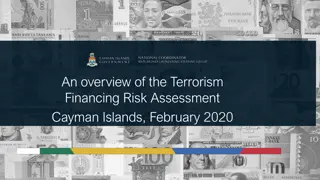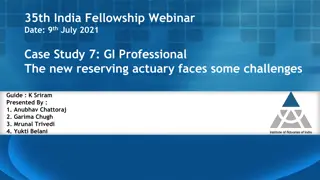Challenges in Pricing Cyber Risk and Terrorism Risk: Impact on Solvency and Reserving Methods
The seminar discusses the challenges in pricing cyber risk and terrorism risk, with a focus on changes in reserving methods as per IRDAI ALSM 2016 and their impact on solvency and reserving. Key areas of consideration under ALSM 2016, valuation of assets, estimation of liabilities, and more are covered, highlighting the role of the Indian Actuarial Profession in serving public interest.
Download Presentation

Please find below an Image/Link to download the presentation.
The content on the website is provided AS IS for your information and personal use only. It may not be sold, licensed, or shared on other websites without obtaining consent from the author.If you encounter any issues during the download, it is possible that the publisher has removed the file from their server.
You are allowed to download the files provided on this website for personal or commercial use, subject to the condition that they are used lawfully. All files are the property of their respective owners.
The content on the website is provided AS IS for your information and personal use only. It may not be sold, licensed, or shared on other websites without obtaining consent from the author.
E N D
Presentation Transcript
27th India Fellowship Seminar Topic: Cyber risk and Terrorism risk - Challenges in pricing Guide Name: Mr. Palreddy Vishnuvardhan General Insurance Changes in reserving methods as per IRDAI ALSM 2016, Impact on solvency and reserving Supervisor: P.A. Balasubramanian, FIAI Girinker Aggarwal Varun Jain Deepanjali Talwar Presenters Names: Date: 1st June 2017 Mumbai Indian Actuarial Profession Serving the Cause of Public Interest
Agenda Overview of ALSM regulations currently in place (2016) Changes Related to Reserving Changes Related to Solvency Indian Actuarial Profession Serving the Cause of Public Interest
Overview of IRDAI ALSM 2016 Key Areas of consideration under ALSM 2016 Valuation of Assets Estimation of Liabilities Determination of Solvency Margin Indian Actuarial Profession Serving the Cause of Public Interest
Valuation of Assets List of specific assets which should be placed with zero value Outstanding balances and premiums in India, not realized within 30 days Premium receivables from State/Central governments, not realized within 180 days Reinsurance balances outstanding for more than 365 days Co-insurer balances outstanding for longer than 90 days Furniture, fixtures, stock and stationary etc Valuation of all other assets in accordance with Regulations and instructions issued by the Authority regarding Preparation of Financial Statements, Auditor Reports Other forms of Capital and Investments Any other regulations applicable Indian Actuarial Profession Serving the Cause of Public Interest
Estimation of Liabilities (1) CLAIMS RESERVES Set across 28 lines of businesses, classified into Motor Health Personal Accident Travel Fire Marine Other Miscellaneous Outstanding Case Reserve (OS Reserves) Estimated using a case by case method , and amount is to be provided in full Can use a statistical method Incurred But Not Reported (IBNR) Claims Reserve Estimated using actuarial principles and methods, certified by the AA Calculated by each year of occurrence and summed to total Assessed on both NET and GROSS of reinsurance basis Should not discount the estimated future development of the paid claims Indian Actuarial Profession Serving the Cause of Public Interest
Estimation of Liabilities (2) PREMIUM RESERVES Unearned Premium Reserve (UPR) Set using prescribed formula, certified by CFO and Statutory Auditor Premium Deficiency Reserve (PDR) Calculated using actuarial principles Maintained at the entity level Unexpired Risk Reserve (URR) = UPR + PDR OTHER LIABILITIES Provision for bad and doubtful debts Reserves for declared/recommended/outstanding dividends Provision of taxation Foreign Exchange Reserves Sundry creditors and other business expenses Indian Actuarial Profession Serving the Cause of Public Interest
Determination of Solvency Margin AVAILABLE SOLVENCY MARGIN (ASM) Excess of assets over liabilities, subject to key specific adjustments Minimum ASM requirements are set in the regulation REQUIRED SOLVENCY MARGIN (RSM) Estimated for 9 lines of business using a standard formula, taking into account Gross and net written premiums, and gross and net incurred claims Taking higher of premiums-based and claims-based RSM calculations Aggregating individual RSMs for all lines into the INSURER s total RSM SOLVENCY RATIO Ratio of ASM to RSM Control level of solvency is set at 150% solvency ratio, breaching which can lead to regulatory actions Indian Actuarial Profession Serving the Cause of Public Interest
Changes Related to Reserving Indian Actuarial Profession Serving the Cause of Public Interest
Detailed Business Split for Reserving Reserves needs to be set for 28 lines of business, increased from 10 lines previously Motor is now split into 8 lines across OD (3 lines) and TP (5 lines) Motor OD and non-pool TP need to reserved under 3 lines each private cars, two wheelers and commercial vehicles Motor TP Pool now needs to be reserved separately for TP Pool and Declined Pool Liability is now split into 3 lines Product Liability, Liability Insurance and Worker s Compensation These need to be reserved separately Indian Actuarial Profession Serving the Cause of Public Interest
Detailed Business Split for Reserving Health is now split into 4 lines Individual, Group-Government, Group-Employer and Group-Other These need to be reserved separately Recognition of new lines of business Personal Accident, split into Individual, Group-Government and Group-Other Crop Insurance Travel Insurance Weather Insurance Credit Insurance Rural Insurance is NOT being specified as separate line anymore Indian Actuarial Profession Serving the Cause of Public Interest
Estimating OS Reserves Actuaries have the provision of using statistical methods for the calculation of reserves for outstanding claims Need to provide justification for the same Appointed Actuary will need to certify the reserves if this method is used Material changes in claims handling practices, leading to changes on outstanding claims reserve pattern should be taken into account and reported Indian Actuarial Profession Serving the Cause of Public Interest
Estimating IBNR IBNR shall be calculated using multiple actuarial methods Loss Ratio Method Basic Chain-Ladder Method (on Incurred and Paid) Bornhuetter-Fergusson Method (on Incurred and Paid) Frequency-Severity Method Rationale for selecting any of the above methods/a different method Detailed notes if estimates from different methods differ significnatly Estimating the IBNR for a line of business IBNR needs to be calculated for each year of occurrence Negative IBNR in any year should be ignored Sum of all years IBNR = total IBNR IBNR shall be calculated on a Gross and Net of reinsurance basis Indian Actuarial Profession Serving the Cause of Public Interest
Estimating URR UPR to be calculated for existing business, needs to be certified by CFO and Statutory Auditor PDR is to be calculated and monitored at the segment level, but reserves need to be kept at the overall ENTITY level These shall be calculated using actuarial principles URR = UPR + PDR Indian Actuarial Profession Serving the Cause of Public Interest
Changes Related to Solvency Indian Actuarial Profession Serving the Cause of Public Interest
Impact of Changes in Asset Valuation Increased Scope of assets that need to be set to 0 Additional assets that are to be placed with value zero, for e.g.: Premiums receivable relating to State/Central govt. not realized within a period of 180 days Debit balance of profit and loss appropriation account balance Co-insurer s balances outstanding for more than 90 days Balances of Indian and Foreign reinsurers (having branches in India) outstanding for more than 365 days Leading to a decrease in the Available Solvency Margin (ASM) Regulation requires Appointed Actuary to sign-off asset valuations Indian Actuarial Profession Serving the Cause of Public Interest
Solvency Ratio Requirements Thresholds specified in the Regulation Every (re)insurer shall maintain its ASM as a higher of 50% of minimum capital i.e. higher of Rs.50 crores for General insurers and Rs.100 crores for Reinsurers or 100% of RSM Control level of Solvency specified as a minimum solvency ratio of 150% Indian Actuarial Profession Serving the Cause of Public Interest
Controls on Solvency Monitoring Greater than 150% No action required from the Regulator Greater than Minimum but less than 150% Company shall be asked to submit a financial plan to correct the deficiency within a specified period not exceeding 6 months Less than Rs.50 crores or 100% of RSM Company shall be deemed to be insolvent and may be wound up by the Court on application made by the Authority Indian Actuarial Profession Serving the Cause of Public Interest
Categorization of Lines of Business PREVIOUSLY Fire, Marine and Miscellaneous were the 3 broad categories; With miscellaneous consisting of Motor, Engineering, Aviation, Liability, Rural, Health and Other In the new regulation, Motor, Engineering, Aviation and Liability have been separated as new categories from Miscellaneous Rural has been removed as a separate line of business Indian Actuarial Profession Serving the Cause of Public Interest
Required Solvency Margin Gross Written Premium incl. Inward Reinsurance Premiums calculated as Trailing 12 months data Gross/Net Incurred Claims incl. Gross/Net IBNR Incurred claims calculated as maximum of Training 12 months data and Trailing 36 months data divided by 3 RSM1 RSM = Higher of RSM1 and RSM2 Factor A is used to scale down Gross Premium. RSM1 is calculated as 20% of HIGHER of Scaled Gross Premium and Net Premium RSM2 Factor B is used to scale down Gross Incurred Claims. RSM2 is calculated as 30% of HIGHER of Scaled Gross Claims and Net Claims Indian Actuarial Profession Serving the Cause of Public Interest
Revised Factors for Calculation of RSM New Regulation has reduced the Factors used to scale down Gross figures Class Fire Marine Cargo Marine - Other than Marine Cargo Motor Engineering Aviation Liability Heath Miscellaneous A/B Class Fire Marine: A/B 0.5 0.5 0.6 Capital required may be lesser, with everything else remaining the same, for an insurance company with higher ceded premiums as a proportion of gross premium Marine Cargo Marine Hull Miscellaneous: Motor Engineering Aviation Liability Rural Others Health 0.7 0.5 0.5 0.75 0.5 0.5 0.75 0.75 0.7 0.85 0.5 0.9 0.5 0.85 0.7 0.85 Indian Actuarial Profession Serving the Cause of Public Interest
Indian Actuarial Profession Serving the Cause of Public Interest























